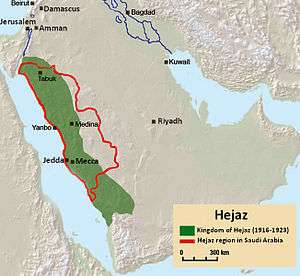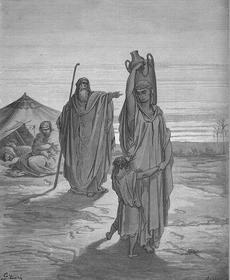Desert of Paran

The Desert of Paran or Wilderness of Paran (also sometimes spelled Pharan or Faran; Hebrew מדבר פארן Midbar Pa'ran), is a location mentioned in the Hebrew Bible. It is one of the places where the Israelites spent part of their 40 years of wandering after the Exodus, and was also a home to Ishmael, and a place of refuge for David.
In Arabic tradition it has often been equated with an area of the Hejaz, around Mecca, linked to Ishmael and Abraham.
Biblical Paran

The Wilderness or Desert of Paran is said to be the place where Abraham's wife Sarai and her Egyptian servant girl Hagar (Genesis 16:1) by permission bore him a son Ishmael were sent into exile from Abraham's dwelling in Beersheba, as a result of which Hagar "departed, and strayed in the wilderness of Beer-sheba" (Genesis 21):
Then God opened her [Hagar's] eyes and she saw a well of water. So she went and filled the skin with water and gave the boy a drink. God was with the boy as he grew up. He lived in the desert and became an archer. While he was living in the Desert of Paran, his mother got a wife for him from Egypt. (Genesis 21:19-22)
Paran is later mentioned in the Book of Numbers as a place where the Israelites temporarily settled during the Exodus:
Then the Israelites set out from the Desert of Sinai and traveled from place to place until the cloud came to rest in the Desert of Paran. (Numbers 10:12) [1]
Paran again features in the opening lines of the Book of Deuteronomy:
These are the words Moses spoke to all Israel in the desert beyond the Jordan--that is, in the Arabah--opposite Suph, between Paran and Tophel, Laban, Hazeroth and Dizahab. (Deuteronomy 1:1)
He said: "The LORD came from Sinai and dawned over them from Seir; he shone forth from Mount Paran. He came with myriads of holy ones, from his right hand went a fiery law for them." (Deuteronomy 33:2)
King David spent some time in the wilderness of Paran after Samuel died (I Samuel).
1 Kings 11:17-18 states that when Hadad the Edomite fled from Edom to Egypt, he passed through Midian and Paran on the way to Egypt. This has led some commentators to suggest the possibility that Paran was a place on the way to Egypt from Edom and Midian.
It is not certain precisely where the wilderness of Paran is to be located. It is often associated with Mount Sinai in Egypt, and there is some evidence that it may originally have referred to the southern portion of the Sinai Peninsula.[2]
Both Eusebius (in his Onomasticon, a Bible dictionary) and Jerome reported that Paran was a city in Paran desert, in Arabia Deserta (beyond Arabia Nabataea), southeast of Eilat Pharan. Onomasticon, under Pharan, states: "(Now) a city beyond Arabia adjoining the desert of the Saracens [who wander in the desert] through which the children of Israel went moving (camp) from Sinai. Located (we say) beyond Arabia on the south, three days journey to the east of Aila (in the desert Pharan) where Scripture affirms Ismael dwelled, whence the Ishmaelites. It is said (we read) also that (king) Chodollagomor cut to pieces those in 'Pharan which is in the desert'."[3]
Eusebius' mention of Chodollagomor here refers to a possible earlier mention of Paran in Genesis 14:6, which states that as he and the other kings allied with him were campaigning in the region of Sodom and Gomorrah, they smote "the Horites in their mount Seir, unto El-paran, which is by the wilderness." (KJV)
Sebeos, the Armenian Bishop and historian, describing the Arab conquest of his time, wrote that the Arabs "assembled and came out from Paran" [4][5]
in 1989, Professor Haseeb Shehada in his translation of the Samaritan Torah suggested an identification of the wilderness of Paran with the desert of Western Arabia which is known today as Hijaz[6]
Arabic traditions
For Arabic People, especially Muslims to link Paran with Mecca is imperative for the very existence of Islam as a religion .. The Arab geographer Al-Muqaddasi mentioned in his book that the Red Sea branches into two "at the extremity of al-Hijaz at a place called Faran".[7]
The association of Paran in Genesis 21:21 with Ishmael and the Ishmaelites is affirmed by the Muslim geographer Yaqut al-Hamawi who writes "Faran, an arabized Hebrew word, one of the names of Mecca mentioned in the Bible."[8] Muslim and Arabic traditions hold that the wilderness of Paran is, broadly speaking, the Hejaz, the northern half of Tihamah, stretching along the east side of the Red Sea starting from Jordan and Sinai,[9] and that the specific site where Ishmael settled is that of Mecca, near the mountains of Paran.[10][11][12][13]
The "Desert of Paran" is also interpreted as Hijaz in an old Arabic translation of the Samaritan Bible. [14] When it was translated into English in 1851, it was found to include a footnote making this interpretation.[15]
The name 'Paran' or 'Faran' has often been used to refer specifically to the wilderness and mountains near where Mecca is situated.[15] al-Hamdani in his book Geography of the Arabic Peninsula says that the Paran mountains around Mecca were named after Paran son of Amalek.[16] Sam'ni in his Book of Surnames also says that the surname Farani is derived from the Faran mountains near Mecca in Hijaz [17]
According to Wahb ibn Munabbih, there was a Tal Faran ("Hill of Faran") on the outskirts of Mecca, mentioned in his book Kitab al-Tijan, a Pre-Islamic Arabic folklore compilation.[8] Ibn Munabbih further suggested an identification for Tal Faran as the 'mound of the Two runaways', a place where the Jurhum tribe found Hagar and Ishmael and thought of them as two runaways.[18]
According to Immanuel Velikovsky, "the desert of Pharan according to the old Arabian sources, neglected by Biblical research, is in the mountainous area of Hedjaz".[19][20] He identified the biblical Kadesh Barnea in the Paran desert with Mecca in the Hejaz desert.[20][21]
See also
- Ishmael
- Hijaz
- Haseeb Shehada
- Wadi Feiran, whose oasis was identified by Ptolemy as "Paran"
References
- ↑ See also Numbers 12:16
- ↑ Brisco, T.V. (1982). Geoffrey W. Bromiley, ed. International Standard Bible Encyclopedia: E-J (Revised ed.). Wm. B. Eerdmans Publishing. p. 241. ISBN 978-0-8028-3782-0.
- ↑ "Onomasticon Biblical Dictionary by EUSEBIUS, entry for Pharan No 917".
- ↑ Sebeos (1999). "30". The Armenian History of Sebeosi. liverpool: liverpool university press. pp. 95–97. OCLC 44228890.
- ↑ Marx, edited by Angelika Neuwirth, Nicolai Sinai, Michael (2010). The Qur'an in context historical and literary investigations into the Qur'anic milieu (PDF). Leiden: Brill. p. 142. ISBN 9789047430322. Archived from the original on March 2000.
- ↑ Professor. Haseeb Shehada (1989) . Translation of the Samaritan Torah, p.90 .Israel Academy of Sciences and Humanities
- ↑ Al-Muqaddasi, Muhammad (1994). The Best Divisions for Knowledge of the Regions. UK: Garnet Pub. p. 11. ISBN 1873938144.
- 1 2 Reuven Firestone (1990). Title Journeys in holy lands: the evolution of the Abraham-Ishmael legends in Islamic exegesis. SUNY Press. pp. 65, 205. ISBN 0585076294.
- ↑ "Hejaz map".
- ↑ "Volume 4, Book 55, Number 584". story of Hagar and Ismael in Mecca. 610 AD. Retrieved 11 May 2013. Check date values in:
|date=(help) - ↑ "Quran Commentary of ibn Kathir mention of Abraham and Ishmael as a boy in the "land of faran"" (PDF).
- ↑ The miracle of the well that happened to Hagar and Ishmael in Mecca is further identified in a hadith of Ibn Ezra with the well Zimum (Zimzum), "where the Arabs hold an annual festival", mentioned as the well of Hagar in Genesis 16:14: "She called the well Be'er Lachai Roi; it is between Kadesh and Bered". Dr Michael Sanders website
- ↑ Marx (1924). Halper's 'Post-Biblical Hebrew literature. Philadelphia. p. 53. OCLC 172997009.
- ↑ Khan, Sayyid (1870). Essays on the life of Muhammad. London: Trubner. p. 75. OCLC 438478.
- 1 2 Sir Sayyid Aḥmad Khān (1870). A series of essays on the life of Mohammad: and subjects subsidiary thereto. London: Trübner & co. pp. 74–76.
- ↑ Hamdani, al-Hasan. Geography of the Arabian Peninsula. p. 285.
- ↑ al_Sam`ni, Abd Al-Karim (1912) [1140 AD]. Kitab al-Ansab: The book of surnames (PDF). London. OCLC 459336183. Archived from the original on March 2000.
- ↑ Al-Munabbih, Wahb bin (2009). Book of crowns on the kings of Himyar = Kitab al-Tigan. Piscataway: Gorgias Press. ISBN 1593335156.
- ↑ Immanuel Velikovsky archive
- 1 2 the Immanuel Velikovsky archive
- ↑ Velikovsky, Immanuel. "Immanuel Collected essays" (PDF). Retrieved 11 May 2013.